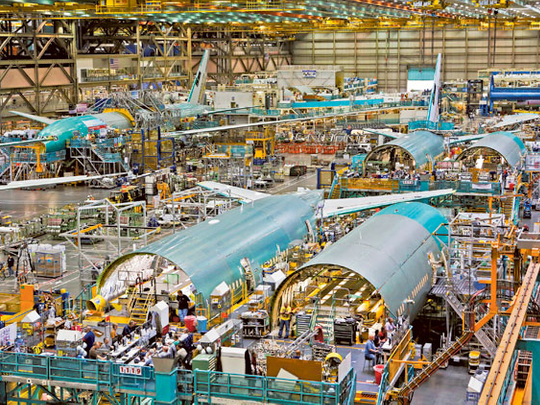
Dubai: US plane-maker Boeing has called 2020 “unprecedented” in terms of disruption to the aviation industry and lowered its forecast for commercial airplane demand.
Boeing has now estimated a demand for 18,350 commercial jets in the next decade, 11 per cent lower than its 2019 forecast. “While this year has been unprecedented in terms of its disruption to our industry, we believe that aerospace and defense will overcome these near-term challenges, return to stability and emerge with strength,” said Marc Allen, Boeing’s Chief Strategy Officer.
See more
- In Pictures: Dubai’s Harbour Marina welcomes first yachts
- The Saudi sites you must see: Top places to visit
- Coronavirus dampens seasonal cheer in China's Christmas production hub
- Philippines: $85 billion infrastructure spending in 104 projects
- Crowds in face masks pack out China auto show after COVID-19 delay
- In Pictures: Learn how to make a sofa or a bed at a traditional furniture factory in Sharjah
However, in the longer term, commercial fleet is expected to return to its growth trend, generating demand for more than 43,000 new airplanes in the next 20 years, Boeing said.
As the impact of the pandemic continues, Boeing said it is “taking action” to reshape its business operations to adapt to the new market reality and become more resilient for the long term. This includes infrastructure, overhead and organization, portfolio and investments, and supply chain health.
Since the start of the pandemic, the company has suspended its dividend, terminated its share buyback program, and reduced discretionary spending and overhead costs, apart from issuing $25 billion in new debt. Boeing had also announced a 10 per cent workforce reduction to align to a smaller market.
“Commercial aviation is facing historic challenges this year, significantly affecting near- and medium-term demand for airplanes and services,” said Darren Hulst, vice president, Commercial Marketing. “Yet history has also proven air travel to be resilient time and again. The current disruption will inform airline fleet strategies long into the future, as airlines focus on building versatile fleets, networks and business model innovations that deliver the most capability and greatest efficiency at the lowest risk for sustainable growth.”
Boeing forecasts a total market value of $8.5 trillion over the next decade, including demand for aerospace products and services, down from previous forecast of $8.7 trillion due to the impact of the COVID-19 pandemic. While airlines globally have begun to recover from a greater than 90 per cent decline in passenger traffic and revenue, but a full recovery will take years, according to the outlook.
The report has also projected a $2.6 trillion market opportunity for defense and space during the next decade.
This reflects the ongoing importance of military aircraft, autonomous systems, satellites, spacecraft and other products to national and international defense. This demand continues to be global in nature with 40 per cent of expenditures expected to originate outside of the United States, the report added.
While near-term commercial services demand is lower, Boeing forecasts a $3 trillion market opportunity for commercial and government services through 2029.
• The global commercial fleet is expected to reach 48,400 by 2039, up from 25,900 airplanes today. During this period, Asia will continue to expand its share of the world's fleet, accounting for nearly 40% of the fleet compared to about 30% today.
• Single-aisle airplanes such as the 737 MAX will continue to be the largest market segment, with operators projected to need 32,270 new airplanes in the next 20 years. Single-aisle demand will recover sooner due to its key role in short-haul routes and domestic markets as well as passenger preference for point-to-point service.
• In the wide-body market, Boeing forecasts demand for 7,480 new passenger airplanes by 2039. Wide-body demand will be affected by a slower recovery in long-haul markets – typical after air-travel shocks – as well as uncertainties from COVID-19's impact on international travel.
• Air cargo demand, a relative bright spot in 2020, is expected to grow 4% annually and generate further demand for 930 new wide-body production freighters and 1,500 converted freighters over the forecast period.








